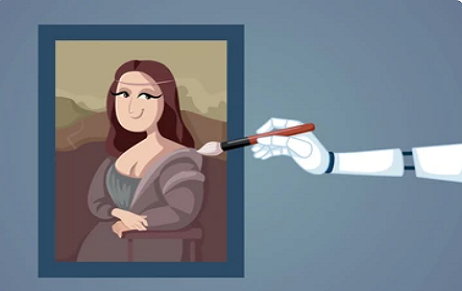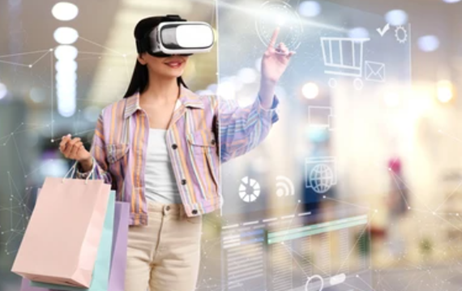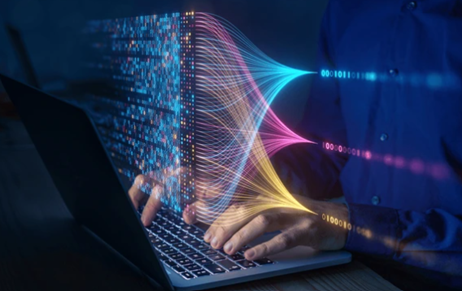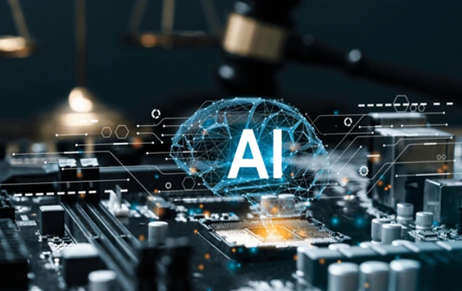In recent years, the world witnessed an exponential surge in the use of Artificial Intelligence…
Pixels And Patents: Decoding A.I. Art & Copyright Law
WHAT IS A.I. ART?
It is an established fact that art and technology have forged a symbiotic relationship over the years. The evolution from traditional tools like pens and pencils to the digital realm to innovative tools like the Apple Pencil redefine artistic expression, these technological advances have not only made art more enjoyable and accessible but has propelled it into a realm of futuristic possibilities. However now with the help of algorithms, Computers now apart from assisting in art works can now analyse effects and patterns learn about colours and then apply the same to thousands of images that has been put into it and then crafting something entirely new. It’s a step beyond assistance; it’s a leap into a realm where technology actively contributes to the creative process, opening up new possibilities. This marks a shift from A.I. assisted work to A.I. generated work.
THE LEGAL FRAMEWORK FOR A.I. ART TO OBTAIN COPYRIGHT
We shall now take a look at copyright Acts of different nations and explore their functionalities concerning Artificial Intelligence and the content created by it. The global stance on A.I. created works can be distilled into three perspectives. Firstly, some countries reject the notion of A.I. as an original author, consequently denying copyright protection to the content it produces. Secondly, nations in this category engage in case-by-case deliberations, often involving ongoing debates and recognizing A.I. authorship with the condition of human co-authorship. Lastly, a distinct set of countries has officially acknowledged A.I. generated works, extending full copyright protection to these creations.
- Non-recognition and No Copyright Grant: In Australia, in the case of Achos Pty Limited V. Ucorp Pty Ltd. In this case the main question arose around the status of HTML Infosafe Code as the appellant has created the Infosafe System using HTML source code. It highlights the appellant’s contention that the respondent copied this system. The key legal question here is whether the court will recognize the AI-generated Infosafe System as an original work entitled to copyright protection. The court came to the conclusion that the HTML source code for the Infosafe is not an original work and is hence not eligible to be granted copyright protection. One can clearly see that the Australian court in this particular case took a rather conservative view that is an in ever evolving landscape where the use of artificial intelligence is now more than ever, such a judgment is a bit concerning as it is in an extremely narrow and restrictive manner and moreover it looks potentially overlooks the expansive creative potential of A.I. In USA, a few months back the artwork of Matthew Allen that is “Theatre D Opera Spatial” cannot be issued a copyright as it is ”too much machine and very less human” this was the reason stated by the U.S. government. There have been three judgments regarding this artwork and all of them state the same reason that copyright laws cannot be extended to artificial intelligence.
- Recognition given on the pre-condition of a human co-author: Majority of the countries adopt a prerequisite for human co-authorship to grant recognition and copyright to AI-generated works. This means that while AI creations may not be acknowledged initially, if a human collaborator is involved, the work becomes eligible for legal protection.For instance in India only a natural person is considered an author under the copyrights act and the definition of ‘artificial intelligence’ is completely exempted from both the copyrights act and the patents act, 1970 as well. In the case of RAGHVAN (which stands for robust artificially intelligent graphics and art visualiser) is an artificial intelligence painting app. In 2020 a bizarre incident occurred where in an initial application filed by the A.I (RAGHVAN) for sole authorship/ownership for an artwork that was created by it was rejected however upon filing the second application where in the co-author was a human, the criteria for a natural person were met and the human and RAGHVAN were named co-authors. This underscores the importance, particularly in India, of attributing authorship to a natural person when seeking protection for works created by AI.
- Official Recognition and Complete Copyright: China is the only country to have officially recognised and give complete copyright to an A.I work, in the case of Shenzen Tencent Computer System Co. Ltd. V. Shanghai Yingmou Technology Co., Ltd.the Shenzhen Nanshan District People’s Court ruled in favour of Tencent against Shanghai Yingmou Technology. The dispute cantered on an article generated by the AI software Dream writer. Tencent published the financial report article via its Tencent Securities website, explicitly crediting Dream writer for its automatic generation. The defendant disseminated the same AI-generated article on their website. The Court recognized Tencent’s use of Dream writer, deeming the article a legal person’s work created by the plaintiff. The ruling ordered compensation for Tencent, marking the first AI-related copyright dispute in Guangdong Province and affirming the legal standing of AI-generated works.
 WHAT COULD BE THE LEGAL COMPLICATIONS OF A.I. ART
WHAT COULD BE THE LEGAL COMPLICATIONS OF A.I. ART
Talking about the elephant in the room, the main issue arises that when an A.I creates something it does it with human intervention thus allowing it to operate in a certain manner and within certain boundaries. Without human intervention if an A.I. is given complete freedom it may violate certain copyright laws and then who will be liable for this because when complete freedom as given to the A.I. this complete freedom meant no human intervention and hence no legal entity can be tied to it and to make matters worse many of the jurisdictions such as Australia, India, Ireland, U.S.A, don’t consider A.I as a legal entity. Who shall be responsible in such a scenario? Moreover according to certain provisions under the Indian copyrights act makes the process even more problematic. Under S.17 of the Indian copyright act, 1957 the author is the first owner of his/her work. However circumstances may evolve where in this ownership might have to be transferred to another individual, now this is possible when the artwork is made by a natural person ownership can be transferred, But when talking about A.I generated work since the jurisdiction does not recognise A.I as a legal entity then such transfer would not be able to take place. Moreover there are other issues as well such as the issue of morality. The artwork created by an A.I is derogatory and is offensive in nature, who will be held liable for an independent work of art solely created by A.I.? if the A.I. is held liable then the only way to apply any ‘punitive’ measures on such acts would be to simply pull the plug and shut the programme down. This would be in turn dangerous for the A.I as it may question its efficiency and accountability.
DOES CREATIVITY NEEDS A HUMAN TOUCH?
Art is always inspired from something. Therefore the artwork created by an A.I. is completely fine because it is simply getting inspired by the information it has to create something that it has been requested to create. However one must understand that art even if imitated, or something drawn from sheer instincts or even sketching still objects it all comes under art. When one asks an A.I to create it something the A.I. is engaging in work as well, scanning through various algorithms, processing images, emotions, using the right kind of colours, etc. One cannot simply say that no work is done or there is alack of emotion or knowledge, As the work that is done more efficient and is being done at a high speed, however the end product that is being produced is art. Thus, whether stemming from human instincts or algorithmic calculations, the resulting creation is a testament to the evolving landscape of artistic expression, showcasing that the essence of art can transcend the traditional realms of inspiration. However this is subjective as if it were true A.I work would have been recognised in all jurisdictions and the need to define ‘natural human’ wouldn’t be there.
CONCLUSION
In conclusion, the area where copyright law and AI art converge is complicated and seen from different angles around the world. China is the only country that formally grants full copyright to AI inventions; other countries condition recognition on human co-authorship, while some countries deny copyright to AI-generated works. Because artificial intelligence is not recognized as a legal entity in many jurisdictions, legal issues emerge, particularly with regard to ownership and responsibility. With artificial intelligence (AI) demonstrating its effectiveness and speed in the creative process, the topic of whether creativity requires a human touch remains subjective. The changing legal structures have to find a way to support AI innovation while also addressing the complex issues raised by autonomous artistic creation.
Author: Vishnu Vardhan, in case of any queries please contact/write back to us via email to chhavi@khuranaandkhurana.com or at IIPRD.
REFERENCES
- Rajiv Sharma, Artificial Intelligence Lacks Personhood To Become The Author Of An Intellectual Property, (Sept. 22, 2023), https://www.livelaw.in/law-firms/law-firm-articles-/artificial-intelligence-intellectual-property-indian-copyright-act-singhania-co-llp-238401.
- Ai Generated Artworks & Copyright – Surana & Surana, (July 4, 2023), https://suranaandsurana.com/2023/07/04/ai-generated-artworks-copyright/.
- Charlotte Kilpatrick, Exclusive: India recognises AI as co-author of copyrighted artwork, Managing Intellectual Property (Aug. 5, 2021), https://www.managingip.com/article/2a5czmpwixyj23wyqct1c/exclusive-india-recognises-ai-as-co-author-of-copyrighted-artwork.
- Acohs Pty Ltd v Ucorp Pty Ltd [2012] FCAFC 16, Center for Study and Research in Intellectual Prop (Feb. 17, 2022), https://csriprnusrl.wordpress.com/2022/02/17/acohs-pty-ltd-v-ucorp-pty-ltd-2012-fcafc-16/.
- Aaron Wininger, Shenzhen Court Rules AI-Generated Articles are Entitled to Copyright Protection, (Jan. 3, 2020), https://www.natlawreview.com/article/shenzhen-court-rules-ai-generated-articles-are-entitled-to-copyright-protection.
- Kate Knibbs, Why This Award-Winning Piece of AI Art Can’t Be Copyrighted, WIRED (Sept. 6, 2023), https://www.wired.com/story/ai-art-copyright-matthew-allen/.
- Rohini Roy, AI Can Now Make Art, But Can Indian Laws Protect Our Artists?, (May 27, 2023), https://www.thequint.com/news/law/artificial-intelligence-creating-art-how-to-protect-artists.

 WHAT COULD BE THE LEGAL COMPLICATIONS OF A.I. ART
WHAT COULD BE THE LEGAL COMPLICATIONS OF A.I. ART

